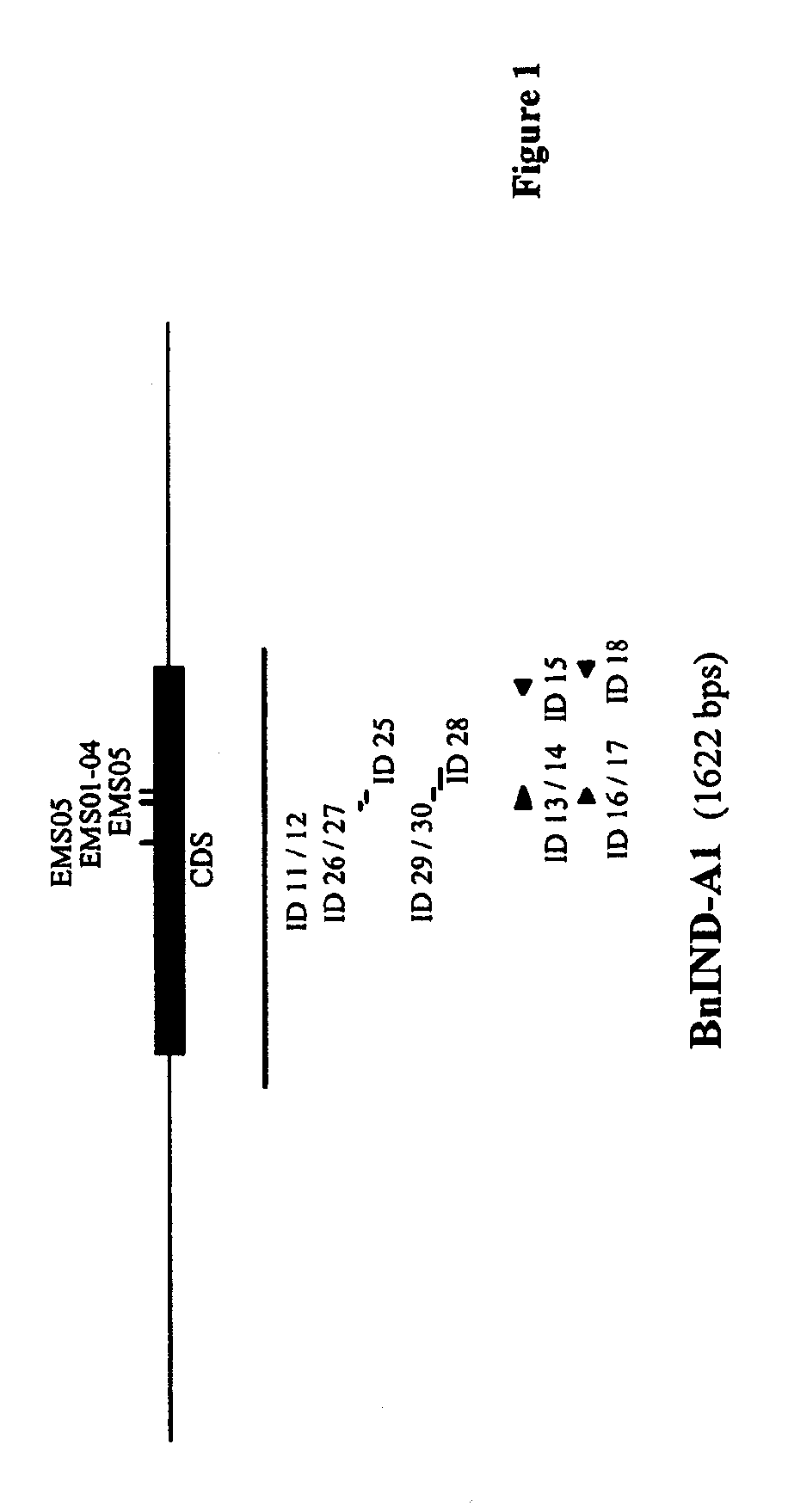Brassica plant comprising a mutant indehiscent allele
a technology of indehiscent alleles and plant roots, applied in the field of agricultural products, can solve the problems of increasing volunteer growth, reducing seed recovery, and shattering of seeds attached to replums, and achieves the effects of reducing seed shattering, reducing seed shattering, and significantly increasing the shatter resistance of the pods
- Summary
- Abstract
- Description
- Claims
- Application Information
AI Technical Summary
Benefits of technology
Problems solved by technology
Method used
Image
Examples
example 1
Isolation of the DNA Sequences of the IND Genes
[0233]To determine the sequences of the IND genes of an elite spring oilseed rape breeding line, a Bacterial Artificial Chromosome (BAC) library of the line was screened as follows:
1.1. Isolation of BAC Clones Comprising an IND Sequence
[0234]To identify Escherichia coli colonies containing a BAC clone comprising an IND sequence of the elite spring oilseed rape breeding line, a BAC library of the line (average clone size of more than 120 kb) arrayed as individual duplicated clones on high density nylon filters were screened by standard Southern hybridization procedures:[0235]A mixture of two probes with the sequence of SEQ ID NO: 2 of WO04 / 113542 (“Bn1-IND”) and SEQ ID NO: 3 of WO04 / 113542 (“BN2-IND”) (SEQ ID NO: 11 and 12, respectively) and labeled according to standard procedures were used for hybridizing to the DNA on the nylon membrane.[0236]Pre-hybridization was performed for 2 hour at 65° C. in 30 ml of the following hybridization ...
example 2
Characterization of IND Gene Sequences from Brassica napus
[0255]After sequencing the genomic DNA fragments (SEQ ID NO: 5 and 7, respectively), the coding regions of the IND sequences were determined with FgeneSH (Softberry, Inc. Mount Kisco, N.Y., USA) and est2genome (Rice et al., 2000, Trends in Genetics 16 (6): 276-277; Mott, 1997, Comput. Applic. 13:477-478) as depicted in the sequence listing.
[0256]Comparison of hybridizing bands generated in a Southern blot analysis on genomic DNA isolated from B. rapa (AA), B. oleracea (CC) and B. napus (AACC) and on BAC clone DNA isolated from the positive colonies identified in Example 1 (restricted with EcoRI and hybridized to probe as described in Example 1) indicated that the IND-A1 sequence originated from the A genome and the IND-C1 sequence from the C genome.
[0257]The protein encoding regions of the IND genes of the elite spring oilseed rape breeding line are represented in SEQ ID NO:1 (IND-A1), SEQ ID NO:3 from the nucleotide at posi...
example 3
Expression of Brassica IND Genes
[0260]To analyze the expression of the different IND genes in different tissues, RT-PCR assays specific for each IND gene were performed on total RNA isolated from Brassica napus leaves, pod walls, dehiscence zone tissue and seeds using the following primers:
INDA1F15′ AGGAGAGGAAGAGATGGATCC 3′(SEQ ID No. 37)INDA1R15′ TGAGTGTGAGGCTGAAGAAGC 3′(SEQ ID No. 38)for the IND-A1 gene, andINDC1F15′ CCTCATCATCTCCTTATGAAC 3′(SEQ ID No. 39)INDC1R5′ CGTATTGCATCTCCTTCATCT 3′.(SEQ ID No. 40)for the IND-C1 gene.
[0261]The results indicated that both IND genes, i.e. IND-A1 and IND-C1, were not expressed in leaf tissue and seeds, but were expressed in dehiscence zone tissue and that the IND-A1 gene was expressed in pod walls, while the IND-C1 gene was not expressed in pod walls.
PUM
| Property | Measurement | Unit |
|---|---|---|
| Tm | aaaaa | aaaaa |
| temperature | aaaaa | aaaaa |
| pH | aaaaa | aaaaa |
Abstract
Description
Claims
Application Information
 Login to View More
Login to View More - R&D
- Intellectual Property
- Life Sciences
- Materials
- Tech Scout
- Unparalleled Data Quality
- Higher Quality Content
- 60% Fewer Hallucinations
Browse by: Latest US Patents, China's latest patents, Technical Efficacy Thesaurus, Application Domain, Technology Topic, Popular Technical Reports.
© 2025 PatSnap. All rights reserved.Legal|Privacy policy|Modern Slavery Act Transparency Statement|Sitemap|About US| Contact US: help@patsnap.com



